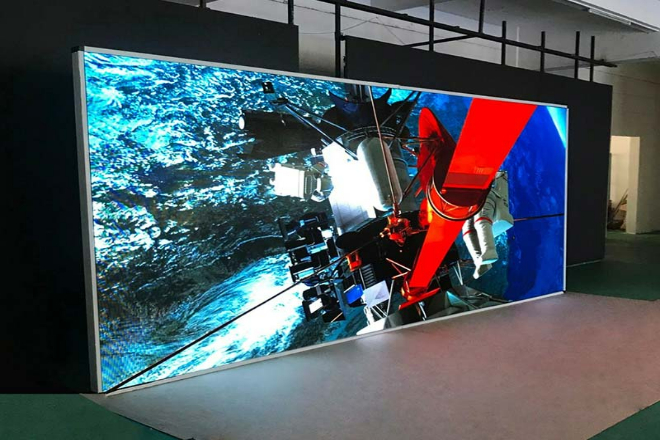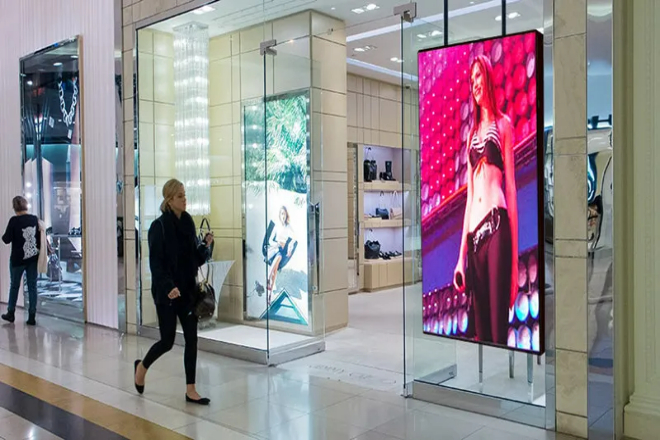序章

With the continuous advancement of technology, the performance of LED表示画面 has become better and better.
Among the many technical parameters, “power consumption” and “power” are two concepts that are often mentioned but easily confused. People often ask: Are the power consumption and power of LED display screens the same thing? The answer is that they are not the same.
1. Basic concepts of power consumption and power of LED display screens
1). What is power?
Power sounds very high-end, but in fact, it is an indicator to measure how much “work” a device can do per unit of time, and this “work” refers to work.
The power we usually talk about is usually measured in watts (W). Imagine that the light bulb in your home is converting electrical energy into light energy when it lights up, and the speed of this conversion, or how much electrical energy it “uses” per second, is power.
In the world of electricity, power is the product of voltage (V) and current (I), which can be simply understood as P=VI. Therefore, high-power devices, like sports cars, are full of power and can quickly convert electrical energy into other forms of energy we need.
2). 消費電力, what is this?
Power consumption is a bit like power, but it is not the same thing. Power consumption, as the name suggests, is how much electrical energy the device “eats” when it is working.
It is also measured by energy consumption per unit of time, and the unit can be watts (W), but if we want to look at the energy consumption for a whole day or a month, we have to use kilowatt-hours (kWh) to calculate.
Power consumption is like the amount of food you eat. The more you eat, the more you consume, and the electricity bill will also increase. Moreover, the value of power consumption is not fixed.
It will change with the working state of the device, the ambient temperature, and the length of time you use it. For example, when the LED display screen is playing dynamic pictures, the power consumption may be greater than when it is playing static pictures.
Therefore, the power consumption indicator can directly reflect how much electricity the device “eats” in actual operation. For those of us who want to save energy, reduce emissions, save money, and save electricity, it is something we must pay attention to.
2. What are the power characteristics of LED display screens?

1). Basic composition of LED display screens
LED lamp beads: As the light-emitting unit of the display screen, the number, type, and arrangement of LED lamp beads directly affect the brightness and display effect of the display screen.
- Driving circuit:
Responsible for providing stable current and voltage to the LED lamp beads to ensure that they can emit light normally. The design of the driving circuit directly affects the energy consumption and stability of the display screen.
- 制御システム:
This is the “brain” of the LED display screen, responsible for receiving and processing external signals and controlling the switching and brightness of the LED lamp beads so as to realize the display of images and text.
- 電源 system:
Provides necessary power support for the entire display screen to ensure that all components can work normally.
- 冷却システム:
Since LED generates heat during operation, an efficient cooling system is essential to maintain the stable operation of the display screen.
- Structural frame:
Used to fix and support the various components of the display screen to ensure its stability and durability.
2). How do you calculate the power of the LED display screen?
The power of the LED display screen is not a simple number. Many factors need to be considered!
- The number and power of LED lamp beads:
It depends on how many LED lamp beads there are. The more lamp beads there are, the greater the power will be. It also depends on the power of each lamp bead. Some lamp beads have high power, while others have low power, which will also affect the overall power.
- 輝度 調整:
Brightness adjustment is also an important factor. The higher the brightness, the greater the power consumption, just like when you turn up the brightness of your mobile phone screen, the power will drop faster.
- Color change:
Color change will also affect the power because the power of lamp beads of different colors may be different, and when changing colors, you may have to light up several lamp beads at the same time!
Of course, the dot pitch and scanning method will also affect the power, but these are more professional, so we won’t go into details here. In short, the power of the LED display is a comprehensive consideration, and all these factors must be taken into account before it can be calculated.
Taking all the above factors into consideration, the power of the LED display can be estimated by the following formula:
P = N × P_led + P_drive + P_control + P_other*
Wherein P represents the total power, N represents the number of LED lamp beads, P_led represents the power of a single LED lamp bead, P_drive represents the power of the drive circuit, P_control represents the power of the control system, and P_other represents the power of other auxiliary equipment.
3). With higher power, will the display be better?
Higher power does not necessarily mean a better display. Although higher power may increase the brightness and make it look brighter, it does not mean that the higher the brightness, the better. Sometimes, the brightness is too high, which will be dazzling and uncomfortable to watch.
Moreover, with higher power, energy consumption will also increase, and the electricity bill will rise sharply. In addition, too much power may also affect the life of LED lamp beads, just like people will feel uncomfortable if they eat too much, and the same is true for lamp beads.
Therefore, when designing an LED display, we must find a balance point that can not only make the display have sufficient brightness, contrast, and clarity but also ensure that the energy consumption is not too high and the life of the lamp beads can be long. In this way, we can enjoy a good-looking picture and save a lot of electricity and maintenance costs!
3. Power consumption analysis of LED display
1). Composition of power consumption:
The power consumption of the LED display is not static. It is divided into two parts: static power consumption and dynamic power consumption. Static power consumption is like the “basal metabolism” of the display, which is the power consumed when it is turned on normally but nothing is displayed.
This power consumption is mainly related to the hardware design and material selection of the display, just like a person’s body shape and physique, which determine the basic consumption.
Then, there is dynamic power consumption, which is a bit more complicated. You can adjust the brightness and change the content display, which will change the power consumption. When the brightness is increased, it is like a person running faster, and the energy consumed naturally increases。
When the content changes quickly, it is like a person moving around constantly, which will also consume more energy. So, the dynamic power consumption will change with the use of the display.
2). How much do you know about the factors affecting power consumption?
There are many factors affecting the power consumption of LED display screens. First of all, the size of the LED screen is an important factor. A larger screen is like a taller person, and the energy consumed will naturally be more.
Then, the resolution is also a key. A higher 解決 is like a person seeing more clearly, but it also consumes more energy to process those details. There is also the refresh rate, which is like the frequency of a person’s blinking. The faster it refreshes, the more energy it consumes.
In addition, the working environment temperature is also a factor that cannot be ignored. When the temperature is high, just like a person sweats when he is hot, the display will also consume more energy to dissipate heat due to heat.
3). Power consumption management, energy saving, and money saving!
So, power consumption management is crucial. Just like a person wants to lose weight, he must control his “intake” and “consumption.”
For LED display screens, energy-saving design is the key. For example, more efficient LED lamp beads, optimized drive circuit design, and improved control system efficiency can be used to reduce power consumption.
In addition, intelligent brightness adjustment technology is also a good thing. Just like human eyes automatically adjust pupil size according to ambient light, LED display screens can also automatically adjust brightness according to the light intensity of the surrounding environment, which can not only ensure display effect but also save energy.
In this way, it can not only reduce energy consumption and operating costs but also make a contribution to environmental protection! Do you think it is worth it?
4. The difference and connection between power consumption and power

1). Power consumption and power are not the same thing!
Speaking of power consumption and power, although they sound like relatives, they are actually two different concepts. Power consumption is like the money we spend on meals, while power is like our appetite. Power consumption is the energy actually consumed by the device during the actual operation.
This value is not fixed. It will fluctuate with the use of the device, environment, and other factors. Just like you sometimes eat more and sometimes eat less, the meal money will naturally be different. The same is true for LED display screens. If the brightness is adjusted higher and the content changes faster, the power consumption will go up.
Power, on the other hand, is more like our physical fitness and the capability of the device itself. Under certain conditions, such as when the voltage and current are stable, the power is a fixed value and will not change.
The power of an LED display depends mainly on its hardware design and manufacturing level, such as the quality of the LED lamp beads, the efficiency of the drive circuit, and the intelligence of the control system.
2). What is the connection between power consumption and power?
Although power consumption and power are not the same thing, they are not completely unrelated. You can think of power as the “basic salary” for calculating power consumption, and power consumption is the accumulation of this “salary” over time.
Power multiplied by time equals power consumption, just like your monthly salary multiplied by the number of working months is your total income for a year.
Moreover, we can also reduce power consumption by optimizing power design to make LED displays more energy-efficient.
For example, choosing some high-efficiency LED lamp beads, designing the drive circuit more sophisticated, or making the control system smarter can make the display consume less energy at the same brightness or display effect. In this way, not only does it reduce operating costs, but it is also environmentally friendly. Isn’t it killing two birds with one stone?
So, although power consumption and power are different, they complement each other. When designing and using LED display screens, we have to consider these two indicators comprehensively and find the best balance point. We can’t just look at power and ignore the energy consumption in actual use.
We can’t just look at power consumption and ignore the performance and capabilities of the equipment. Only in this way can we make LED display screens both easy to use and energy-saving and truly green, environmentally friendly, efficient, and convenient!
結論
In summary, although the power consumption and power of LED display screens are closely related, they have their own characteristics.
Power, as a basic indicator to measure the working ability of the equipment, provides a theoretical upper limit for the design, while power consumption reflects the energy consumption of the equipment in actual operation and is a key parameter for evaluating its energy efficiency and economy.
最後に、LED ディスプレイ スクリーンについて詳しく知りたい場合は、弊社までお問い合わせください。
